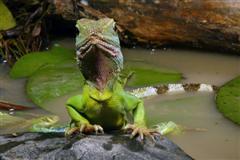Water Dragon - Chinese
Water Dragon, Green Water Dragon Scientific Name: Physignathus cocincinus
Thu, 21st November, 2024 - 7:22 pm GMT
Sponsor Ads:

Alternative Name
Water Dragon, Green Water Dragon Scientific Name: Physignathus cocincinusBasic Info
Chinese Water Dragons are lovely green lizards that appear to be mostly tail: the striped brown and green tail makes up about three-quarters of its full length. Males grow to be about three feet and females about two feet long, though some females can grow as larger, or larger than males. They are green with vertical stripes of a contrasting green color. Green Water Dragons have colorful throats, ranging from pink or peach to brighter shades of orange. They have triangular heads and a small shiny spot between the eyes, which Water Dragons use to thermo-regulate and sense light. The hind legs are more muscular than the slim front legs, and like us, Water Dragons have five toes. They have sharp claws and the middle toe is the longest toe. It is difficult to visually distinguish between the sexes and nearly impossible until the Water Dragon is sexually mature, though generally males are larger and have more pronounced heads and jowls.
Health
Should you care to have more than one, a male and female or several females will get along nicely. Please be sure not to put two male Water Dragons in an enclosure, as they will fight. Water Dragons should be misted every day because they need the humidity to be above 80% all the time. Chinese Water Dragons need a large enclosure, four feet by two feet by two feet should provide the proper space needed to house one adult, though the larger the enclosure the better. Multiple dragons will require more space. Provide them with a water bath for drinking and bathing and a basking spot of about 85 to 90 degrees. Water should be cleaned daily, as they tend to deficate in their water. The rest of the enclosure should remain about 75 to 80 degrees Fahrenheit. At night the temperature should be in the lower seventies. Provide full-spectrum UV light for 12 to 14 hours a day. They also seem to like a good misting every few days. Chinese Water Dragons also need plants and branches to climb on, and females need a box about eight inches deep filled with moist soil in which to lay their eggs. Female Water Dragons may lay eggs even if they have not been bred and could become egg-bound if they can not find a suitable nesting spot, so this is very important. Water Dragons can jump, so it is important to make sure their enclosure is covered with a ventilated screen to prevent escapes. Be sure to handle your Water Dragon for only a few minutes each day until it has become used to you, and beware of its tail! If nervous, the Water Dragon will whip its tail at you, which can be very painful, and if terrified, it may bite. Breeding Chinese Water Dragons are easy to breed and this should be attempted only when the throats have reached their final bright color, indicating sexual maturity. Be sure the female is given a place to hide from the male, as he may become aggressive during the mating season. Generally, eggs require two months to hatch and before laying the Water Dragon may lose her appetite. Hatchlings are generally five to six inches long, with four to five inches of this comprised of their tails alone. They are a dull brown-green color with lighter vertical stripes and a lighter, whitish underside.Habitat
Live in the tropical, wet forests of Thailand, Southern China, Cambodia, and Vietnam, loving especially areas near a water sourceBehavior
The Chinese Water Dragons, or Green Water Dragons, are well known and appreciated for their appealing personalities. Native to the tropical rainforests of Southeast Asia, Chinese Water Dragons are arboreal lizards that are active during the day. They swim on occasion and can even run standing only on their hind legs! Some may also occasionally eat pinkies. Water Dragons have calm, amiable personalities with handling and will grow to be very rewarding pets with proper treatment. With patience and kind and gentle treatment the Chinese Water Dragon will usually become very easy to handle. They average Chinese Water Dragon lives for fifteen years.Origin
AsiaHistory
In the wild, Chinese Water Dragons live in the tropical, wet forests of Thailand, Southern China, Cambodia, and Vietnam, loving especially areas near a water source. Unfortunately, because they are so valued as pets, they are stolen from the wild. To prevent their extinction, keep only captive bred animals as pets. Captive-bred Water Dragons generally have more calm and docile personalities than wild-caught animals.Common Foods
Chinese Water Dragons are omnivorous and eat lots of insects and small amounts of fruit. In captivity, crickets, mealworms, earthworms and fruit such as bananas, with a calcium supplement (that is phosphorous and D3 free) should be dusted on the food.Sponsor Ads:
Those who cannot remember the past are condemned to repeat it. -- George Santayana
Water Dragon - Chinese
Coded by: BGID® | ALL RIGHTS RESERVED Copyright © 2000-2024
Disclaimer | Privacy | Report Errors / Contact | Credits



 Beware the new Naval power, they are planning to come on stream with big naval might to match their ground forces. Chinese Aircraft Carrier - Chinese Navy
Beware the new Naval power, they are planning to come on stream with big naval might to match their ground forces. Chinese Aircraft Carrier - Chinese Navy  versus
versus 
 versus
versus  This Thread is about the North Korean Military itself - the kind of army, navy, and air force they have.
This Thread is about the North Korean Military itself - the kind of army, navy, and air force they have. 
 versus
versus  versus
versus 
 versus
versus  versus
versus